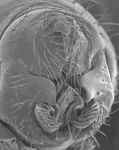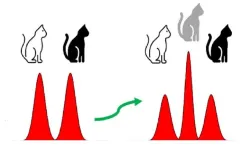(Press-News.org) In the fossil record, trees typically are preserved with only their trunks. They don’t usually include any leaves to show what their canopies and overall forms may have looked like. But now, researchers reporting in the journal Current Biology on February 2 describe fossilized trees from New Brunswick, Canada with a surprising and unique three-dimensional crown shape.
“The way in which this tree produced hugely long leaves around its spindly trunk, and the sheer number over a short length of trunk, is startling,” says Robert Gastaldo of Colby College in Waterville, Maine.
The forms taken by these 350-million-year-old trees look something like a fern or palm, even though palms didn’t arise until 300 million years later, he explains. However, the functional leaves in ferns or palm trees cluster at the top and are relatively few.
“In contrast, Sanfordiacaulis preserves more than 250 leaves around its trunk, with each partially preserved leaf extending 1.75 meters from it,” Gastaldo says. “We estimate that each leaf grew at least another meter before terminating. This means that the ‘bottle brush’ had a dense canopy of leaves that extended at least 5.5 meters (or 18 feet) around a trunk that was non-woody and only 16 centimeters (or 0.5 feet) in diameter. Startling to say the least.”
This work was made possible by a long-term international collaboration with Matthew Stimson and Olivia King of the New Brunswick Museum, Saint John, and Saint Mary's University in Halifax. The researchers’ findings offer important insights into the evolution of plants and arborescence, meaning plants that grow to a tree height, or at least 15 feet at maturity. They’re also a reminder that over the history of life on Earth, there have existed trees that look unlike any we’ve ever seen before and some that look as though they may come from the imagination of Dr. Seuss, the researchers say.
“We all have a mental concept of what a tree looks like, depending on where we live on the planet, and we have a vision of what is familiar,” Gastaldo says. “The fossil on which we report is unique and a strange growth form in the history of life. It is one of evolution’s experiments during a time when forest plants underwent biodiversification, and it is a form that seems to be short lived.
The fossils in question were preserved by earthquake-induced, catastrophic burial of trees and other vegetation along the margin of a rift lake. The first fossil tree was unearthed about 7 years ago from a quarry, but it only included one partial sample. It took several years for another four specimens of the same plant, in close spatial proximity, to also be found, Gastaldo says.
One of the specimens revealed how the leaves departed from the top of the tree, which makes it “absolutely unique.” It’s one of only a few in a fossil record spanning more than 400 million years in which a trunk is preserved around which the crown leaves are still attached, the researchers say.
“Any fossil tree with an intact crown is a rarity in the history of life,” Gastaldo says. “Having the crown leaves attached to a trunk, by itself, begs the questions what kind of plant is it, how is that plant organized, And is it some form that continues to the present, or is it outside of the ‘normal’ concept of a tree? All of these questions, and more, led to this multi-year endeavor.”
The researchers report that the tree likely relied on its unusual growth form to maximize the amount of light it could capture and reduce its competition with other plants on the ground. They suggest that the tree now represents the earliest evidence of smaller trees growing beneath a taller forest canopy. It means that plant life in the Early Carboniferous period was more complex than expected, suggesting Sanfordiacaulis lived at a time when plants were “experimenting” with a variety of possible forms or architectures.
“The history of life on land consists of plants and animals that are unlike any of those that live at the present,” Gastaldo says. “Evolutionary mechanisms operating in the deep past resulted in organisms that successfully lived over long periods of time, but their shapes, forms, growth architectures, and life histories undertook different trajectories and strategies. Rare and unusual fossils, such as the New Brunswick tree, is but one example of what colonized our planet but was an unsuccessful experiment.”
####
Current Biology, Gastaldo et al. “Enigmatic fossil plants with three-dimensional, arborescent-growth architecture from the earliest Carboniferous of New Brunswick, Canada” https://cell.com/current-biology/fulltext/S0960-9822(24)00011-3
Current Biology (@CurrentBiology), published by Cell Press, is a bimonthly journal that features papers across all areas of biology. Current Biology strives to foster communication across fields of biology, both by publishing important findings of general interest and through highly accessible front matter for non-specialists. Visit http://www.cell.com/current-biology. To receive Cell Press media alerts, contact press@cell.com.
END
Embargoed until 11am ET USA/4pm GMT UK on Friday 2 February (Current Biology embargo)
-With pictures-
Fruit flies have provided scientists with new insight into the genetic basis for the rapid evolution of male external genitalia driven by sexual selection.
Secondary sexual characteristics such as peacocks’ tails and the male external genitalia of insects are known to be among the fastest evolving animal body parts.
It is thought that this is driven by sexual selection including through female choice and the different evolutionary needs of each sex to find the right mate and maximise their fitness.
Now scientists at Durham University and Oxford ...
About The Study: The findings of this study of 1,404 mental health treatment facilities indicate that there were no differences in the availability of mental telehealth services based on the prospective patient’s clinical condition, perceived race or ethnicity, or sex; however, differences were found at the facility-, county-, and state-level. These findings suggest widespread disparities in who has access to which telehealth services throughout the U.S.
Authors: Jonathan Cantor, Ph.D., of the RAND Corporation in Santa Monica, California, is the corresponding author.
To access the embargoed study: Visit ...
About The Study: This study including 432,000 patients who underwent major surgery for eight cancer types found an increased rate of venous thromboembolism associated with cancer surgery. The risk persisted for about two to four months postoperatively but varied between cancer types. The increased rate is likely explained by the underlying cancer disease and adjuvant treatments. The results highlight the need for individualized venous thromboembolism risk evaluation and prophylaxis regimens for patients undergoing different surgery for different cancers.
Authors: Johan ...
Telehealth availability for mental health care varies significantly across states -- from less than half of treatment facilities contacted in states like Mississippi and South Carolina to every facility contacted in states like Maine and Oregon, according to a new RAND study.
Researchers found there were differences in services offered depending on whether a mental health treatment facility was located in in a rural or metropolitan area.
The types of services offered -- and the types of telehealth modalities available -- also varied widely among ...
About The Study: The results of this study of 89,000 adults suggest that wellness visits and preventive health screenings in the U.S. have not returned to pre-pandemic levels. Screening rates for blood pressure, cholesterol, blood glucose, and common cancers were lower in 2021 versus 2019, and varied across racial and ethnic groups, with Asian adults experiencing the most pronounced declines. These findings support the need for public health efforts to increase the use of preventive health screenings among eligible adults.
Authors: Rishi K. Wadhera, ...
A team of researchers from the Badalona Applied Research Group in Oncology (B·ARGO) and the Urologic Tumours Unit of the Institut Català d'Oncologia (ICO) and the Germans Trias i Pujol Research Institute (IGTP) have found a new therapeutic strategy for patients with a specific subtype of metastatic prostate cancer resistant to standard chemotherapy treatment with docetaxel.
In this study, published in the journal Frontiers in Pharmacology, they propose a new treatment based on a combination of kinase inhibitors in patients who inevitably stop responding to docetaxel. The team found that resistance to this drug is associated with the hyperactivation ...
The aim of this clinical trial, which has just received approval in France, is to assess the safety and efficacy of a new gene therapy drug in children aged between 6 and 31 months with profound hearing loss. Audiogene was developed by a French consortium composed of teams from the Hearing Institute, an Institut Pasteur research center; the ENT Department and Pediatric Audiology Research Center at Necker-Enfants Malades Hospital (AP-HP); Sensorion and Fondation Pour l'Audition. The trial has also been submitted to other European countries and is currently undergoing assessment.
Audiogene is the first clinical trial in France to test a gene therapy drug, SENS-501, ...
A new vaccine shows encouraging early results as a potential off-the-shelf treatment for certain patients with pancreatic or colorectal cancer, according to a study co-led by researchers at Memorial Sloan Kettering Cancer Center (MSK). The vaccine targets tumors with mutations (or changes) in the KRAS gene, a driving force in many cancers.
This cancer vaccine is different from another type of pancreatic cancer vaccine, which is custom-made for each patient using messenger RNA (mRNA). Both are therapeutic vaccines given after surgery ...
There has been significant progress in the field of quantum computing. Big global players, such as Google and IBM, are already offering cloud-based quantum computing services. However, quantum computers cannot yet help with problems that occur when standard computers reach the limits of their capacities because the availability of qubits or quantum bits, i.e., the basic units of quantum information, is still insufficient. One of the reasons for this is that bare qubits are not of immediate use for running a quantum algorithm. While the binary bits of customary computers store information in the form of fixed values of either 0 or 1, qubits can represent 0 and ...
Researchers at the University of São Paulo (USP) and the Federal University of Viçosa (UFV) in Brazil have developed a sustainable sensor that can be placed directly on the surface of a vegetable or fruit to detect the presence of pesticides. Known for this reason as “plant-wearable”, it is made of cellulose acetate, a material derived from wood pulp.
The device has the potential to help assure food safety in a world that increasingly suffers from a shortage of food and the environmental and health problems caused ...







